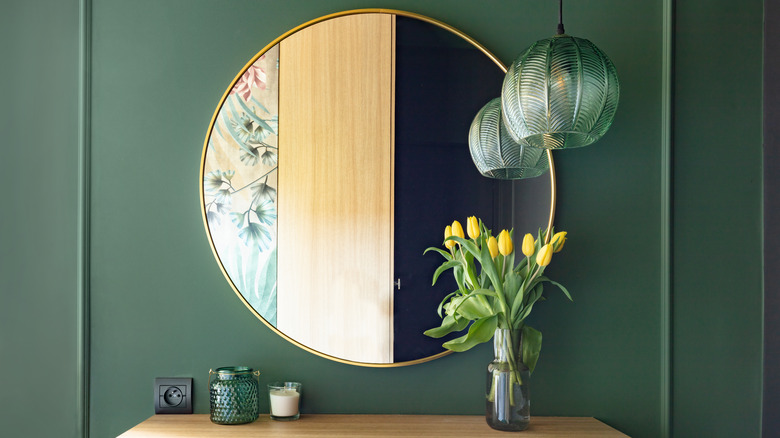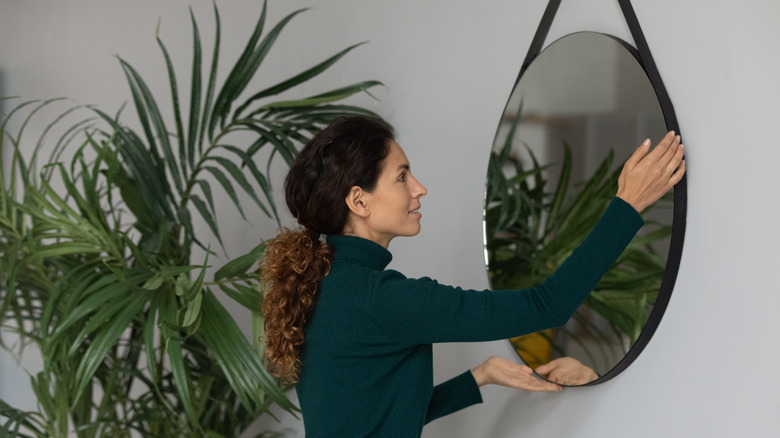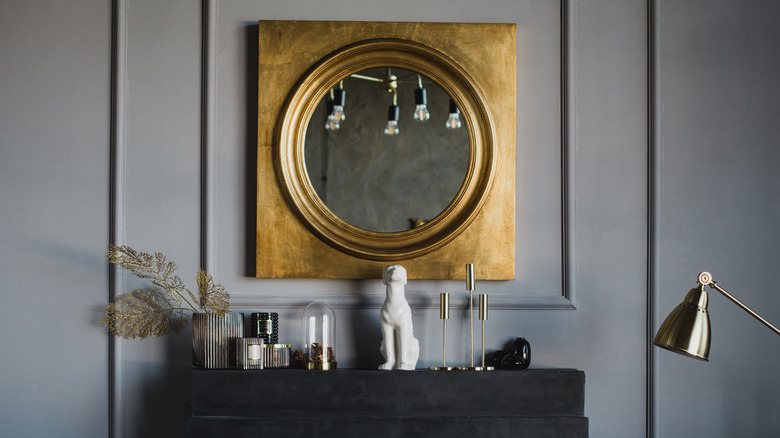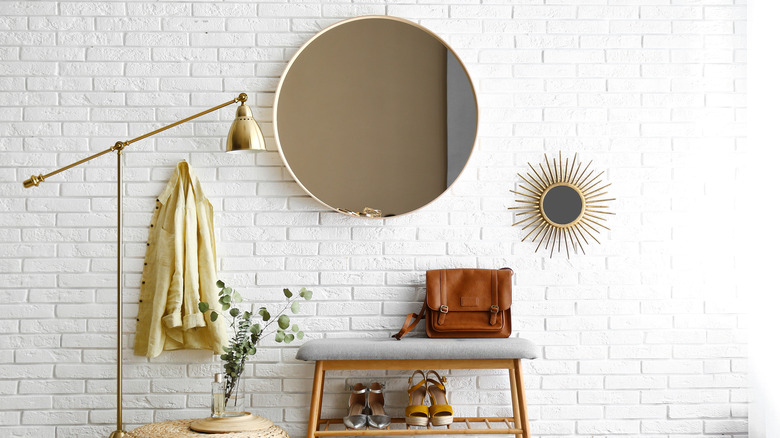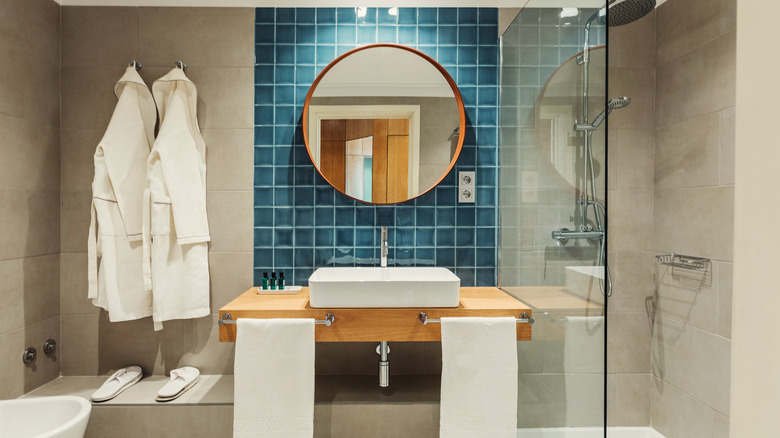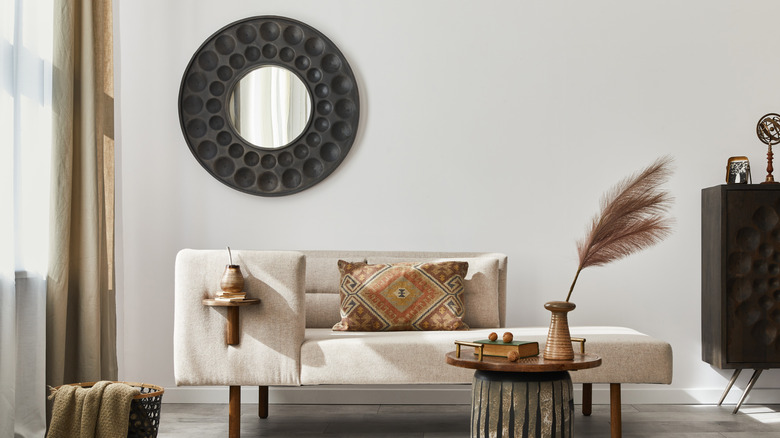The Safest Way To Install A Heavy Mirror In Your Home
Mirrors are staple furniture and decorative items in almost every home. Aside from allowing you to view yourself, mirrors can help tie a room together, add design flair, and make smaller rooms feel larger, as Giant Glass & Mirror points out.
There are plenty of ways to use mirrors in your home, including propping up a standing floor mirror, placing a small one on your vanity, attaching one over a door with hooks, or hanging them on a wall. Hanging a mirror is not as easy as it sounds, though. Mirrors are incredibly fragile, being mostly made out of glass. They also tend to be very heavy — aside from the weight of the glass itself, more elaborate frames can be incredibly heavy. If a mirror falls from your wall, the results could be very damaging. Not only would the glass shatter and create a dangerous mess, but your walls and floors could also be seriously damaged in the process. As such, knowing how to safely hang a heavy mirror is incredibly important.
Preparation
As with most home projects, before you begin, you'll need to prepare. When it comes to hanging a heavy mirror, you need to take certain safety precautions to protect your walls and floors. The Home Depot says you should first determine what material your wall is made of since that will determine the type of hardware you'll need. Typically, internal walls are made of drywall, plaster, or brick.
You also need to know the weight of your mirror. Hardware varies not only depending on the wall material but how heavy the object being hung is. Luckily, the packaging will almost always reflect what material it should be used on, as well as display a maximum weight. You can use a simple bathroom scale to find out the weight of your mirror. If your home has drywall, you may also need to use a stud finder to locate the wooden framing.
Use French cleat hangers
One great hardware option for hanging heavy objects, especially mirrors, is cleat hangers. According to ArtNews, cleats are interlocking metal brackets that are installed on both the top of the mirror frame and the wall. The cleats wedge into each other, which secures the frame and its weight safely on the wall.
Make sure your wall material is compatible with the cleats and that they can hold the weight of your frame. Install the cleats on the top of the frame first. The hardware package will likely come with appropriate size screws. To make the holes, Lowe's recommends using an awl to make a shallow hole on the frame and then attaching it with the provided screws. Figure out where you want your mirror to hang, and then mark on the wall where the corresponding cleat will go. Attach it to the wall with screws, and slide the top cleat into the bottom.
Molly bolts for plaster walls
One option for hanging a heavy mirror on plaster walls is molly bolts, explains Instructables. A molly bolt is a hollow, metal wall anchor that expands inside the wall to hold more weight than a typical screw, and is ideal for heavy objects.
Begin by measuring and marking where you want to install your mirror. If you only have one mounting hole on your mirror, you'll only need to mark where you want it to go on the wall. If you have two, though, measure the distance between the holes, and mark the wall where you want each screw to go. For a professional finish, consider first using painter's tape and a spirit level to make a straight line on the wall. To install the Molly bolts, drill a hole into the marks on your wall, opting for a drill bit just slightly larger than the bolt. Insert the bolt, tap it into place with a hammer, and use a screwdriver to tighten the bolt and expand the anchor wings. Then, simple hang your mirror on the exposed screw heads.
Install D-rings on the frame
Some mirrors may not come with hardware on the frame at all. In that case, one of the easiest ways to add hanging hardware is with D-rings. D-rings are, as the name suggests, D-shaped metal rings that hang securely on nails or screws in the wall. To start installing your D-rings, you first need to decide how high you want the top of your mirror to be, per UTR Decorating.
Then, measure the length of your mirror frame, top to bottom, and divide that number by three. Using that number, mark the top third of your frame, as this is where the D-ring will go. A simple screwdriver should be strong enough to connect the ring to your frame, but if not, you can use a drill — just be careful not to damage the frame or mirror. From there, you can attach the mirror to the wall using the same method as the molly bolts.
Strengthen with hanging wire
D-rings are very sturdy and safe hardware for heavy items like mirrors, but you can further strengthen them with hanging wire. As a bonus, you'll likely only need to make one hole in your wall, as the mirror will hang from the peak of the wire as opposed to two hooks. There are a few different types of wires with different weight capacities. According to Picture Hang Solutions, traditional braided wire is the weakest, holding anywhere from 12 to 36 pounds. Next is vinyl-coated stainless steel wire, which holds 25 to 60 pounds. The strongest is stainless steel picture wire, which supports 25 to 100 pounds.
Once you have selected the correct wire, you need to know how to safely tie it around the D-rings. Begin by threading the wire through each end of the rings, leaving at least 5 inches of excess, suggests Sammy on State. Use the excess wire to pull it over and under the ring, and then up through it once more — this should create a small knot. Next, start winding the excess wire up the center of the main wire. Make sure to leave a little slack in the wire, and then hang it on the wall.
